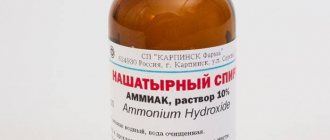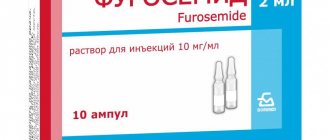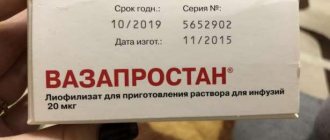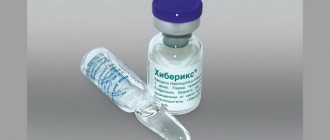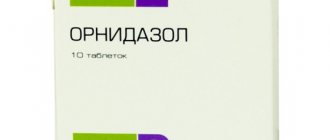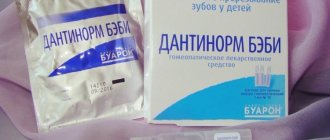The pharmaceutical market is simply overflowing with antispasmodic drugs. Among them are Halidor injections, which can effectively eliminate cardiovascular disorders and alleviate spastic conditions in humans. In the article we will look at why injections are useful, how to use them correctly, and to whom they are indicated.
Pharmacological properties of the drug Halidor
Halidor has a myotropic antispasmodic and vasodilator effect. Reduces the tone and motor activity of smooth muscles of internal organs. The blood pressure level is slightly affected. Has weak local anesthetic activity. Causes a moderate sedative effect. Inhibits platelet aggregation. Quickly and completely absorbed into the gastrointestinal tract. The maximum concentration in blood plasma is achieved 3 hours after administration. The half-life is 6 hours. About 97% of the dose taken is excreted in the urine in the form of inactive metabolites.
Halidor tab.100mg N50 41820
Description
Halidor® EGIS Pharmaceuticals PLC (Hungary) tablets 100 mg; bottle (bottle) of dark glass 50, cardboard pack 1; EAN code: 5995327206219; No. P N014344/01, 2008-12-24 from EGIS Pharmaceuticals PLC (Hungary) Latin name Halidor® Active ingredient Bencyclane* (Bencyclanum) ATC: C04AX11 Bencyclane Pharmacological groups Antispasmodic agent [Vasodilators] Antispasmodic agent [Myotropic antispasmodics] Nosological classification (ICD -10) A09 Diarrhea and gastroenteritis of presumably infectious origin (dysentery, bacterial diarrhea) I63 Cerebral infarction I67.9 Cerebrovascular disease, unspecified I73.0 Raynaud's syndrome I73.8 Other specified peripheral vascular diseases I73.9 Peripheral vascular disease, unspecified K25 Gastric ulcer K26 Duodenal ulcer K29.5 Chronic gas street unspecifiedK52.9 Non-infectious gastroenteritis and colitis, unspecifiedK58 Irritable bowel syndromeK80 Gallstone disease [cholelithiasis]K81 CholecystitisK83.4 Spasm of the sphincter of OddiK91.5 Postcholecystectomy syndromeN20 Kidney and ureteral stonesN21 Lower urinary tract stonesN23 Renal colic, unspecifiedN999* Diagnosis of urinary diseases genitourinary systemR10.4 Others and unspecified abdominal pain R14 Flatulence and related conditions R30.1 Bladder tenesmus Z100* CLASS XXII Surgical practice Description of dosage form Tablets: white or greyish-white, round, flat, bevelled, engraved “HALIDOR” on one side, with a faint characteristic odor . Solution for injection: transparent, colorless solution, odorless. Pharmacological action Pharmacological action - myotropic antispasmodic, vasodilating. Pharmacodynamics Bencyclane is a myotropic antispasmodic with a pronounced vasodilating effect. The vasodilatory effect of bencyclane is mainly associated with its ability to block calcium channels, its antiserotonin effect and, to a lesser extent, with the blockade of sympathetic ganglia. In addition, bencyclane has an antispasmodic effect on the visceral muscles (gastrointestinal tract, genitourinary organs, respiratory organs). The drug causes a slight increase in heart rate. Its weak tranquilizing effect is also known. Bencyclane can cause dose-dependent suppression of Na+/K+-dependent ATPase and platelet and erythrocyte aggregation, as well as an increase in erythrocyte elasticity. These effects are observed mainly in peripheral vessels, coronary arteries and cerebral vessels. Pharmacokinetics Bencyclane is well absorbed from the gastrointestinal tract. Cmax in blood plasma is achieved 2–8 hours (usually 3 hours) after oral administration. Due to first-pass metabolism through the liver, the bioavailability of the drug after oral administration is 25–35%. Approximately 30–40% of the amount of bencyclane in the circulating blood is associated with plasma proteins, 30% with erythrocytes, 10% with platelets; the free fraction is 20%. Metabolism occurs in the liver, mainly in two ways: dealkylation produces a demethylated derivative, and cleavage of the ester bond produces benzoic acid, which is subsequently converted to hippuric acid. The main part of the administered dose is excreted in the urine, mainly in the form of metabolites, unchanged - 2-3%. A significant amount of metabolites (90%) are released in unconjugated form, and a small part is released in conjugated form (approximately 50% as a conjugate with glucuronic acid). T1/2 is 6–10 hours; this parameter does not change in elderly patients, as well as in cases of impaired renal and liver function. The total clearance is 40 l/h, renal clearance is less than 1 l/h. Indications for the drug Halidor® Vascular diseases - peripheral vascular diseases: Raynaud's disease, other diseases with acrocyanosis and vasospasm, as well as chronic occlusive arterial diseases; — cerebral vascular diseases: in complex therapy of acute and chronic cerebral ischemia. Elimination of spasm of internal organs - gastrointestinal diseases: gastroenteritis of various etiologies (especially infectious), infectious and inflammatory colitis, functional diseases of the large intestine, tenesmus, postoperative flatulence, cholecystitis, cholelithiasis, condition after cholecystectomy, motility disorders with dyskinesia of the sphincter of Oddi , stomach or duodenal ulcer - in combination with other medications; - urological syndromes: spasms and tenesmus of the bladder, concomitant therapy for urolithiasis (in combination with analgesics for renal colic). Additionally for injection solution: preparation for instrumental research methods in urology. Contraindications: hypersensitivity to the active or any other component of the drug; severe respiratory, renal or liver failure; decompensated heart failure, acute myocardial infarction, AV block. epilepsy or other forms of spasmophilia; recent hemorrhagic stroke; traumatic brain injury (within the last 12 months); pregnancy (see “Use during pregnancy and lactation”); breastfeeding (see “Use during pregnancy and breastfeeding”); children under 18 years of age (due to lack of clinical data). Use during pregnancy and lactation Data from preclinical studies have not revealed any embryotoxic or teratogenic effects. However, sufficient reliable studies on the use of the drug during pregnancy and lactation in humans have not been conducted. Therefore, administration of the drug to patients in the first trimester of pregnancy is not recommended. During lactation, you should refrain from prescribing the drug or decide whether to stop breastfeeding during treatment. Side effects From the gastrointestinal tract: dry mouth, abdominal pain, feeling of fullness, nausea, vomiting. From the side of the central nervous system: anxiety, headache, dizziness, gait disturbance, tremor, sleep disturbance, memory loss; rarely - transient confused state of consciousness, hallucinations, asthenia (pills); very rarely - symptoms of focal damage to the central nervous system, epileptiform seizures (tablets). From the cardiovascular system: sometimes atrial or ventricular tachyarrhythmia may occur (especially when administered together with other proarrhythmogenic drugs). Laboratory indicators: transient increase in AST and ALT activity, leukopenia. Others: general malaise, weight gain, allergic reactions; rarely - thrombophlebitis with intravenous administration (solution for injection). Interaction Caution should be exercised when combined with the following drugs: - anesthetics and sedatives - their effects may be enhanced; — Medicines for general anesthesia — enhancing their effect; - sympathomimetics - due to the risk of atrial and ventricular tachyarrhythmias; - drugs that reduce blood potassium levels and quinidine - due to the possible summation of proarrhythmogenic effects; - digitalis preparations - the risk of arrhythmia increases with an overdose of digitalis; - beta-blockers - due to the opposite chronotropic effect (negative for beta-blockers and positive for bencyclane), it may be necessary to select the dosage of the beta-blocker; - CCBs and other antihypertensive drugs - due to the possibility of enhancing their effect; - drugs that cause side effects in the form of spasmophilia, - due to the possibility of summation of these effects; - acetylsalicylic acid - due to increased inhibition of platelet aggregation. Overdose Symptoms: increased heart rate, decreased blood pressure, collapse, urinary incontinence, drowsiness, anxiety, and in severe cases, epileptiform seizures. Significant overdose can cause tonic-clonic seizures. Treatment: specific antidote is unknown. In case of an overdose of tablets, gastric lavage. Carrying out symptomatic therapy. Benzodiazepines are recommended for the treatment of seizures. There is no data on the possible removal of bencyclane by dialysis. Special instructions Tablets. During long-term therapy with bencyclane, regular monitoring of the rheological properties of blood is recommended (approximately once every 2 months). When used simultaneously with drugs that cause hypokalemia, cardiac glycosides, and drugs that have a depressant effect on the myocardium, the daily dose of Halidor® should not exceed 150–200 mg. Injection. Injection sites should be changed periodically, because the drug can cause damage to the vascular endothelium and thrombophlebitis. You should refrain from parenteral administration of the drug to patients with severe cardiovascular or respiratory failure, predisposed to collapse, as well as prostatic hypertrophy and urinary retention (the degree of retention increases with relaxation of the bladder muscles). During long-term therapy with bencyclane, regular laboratory tests are recommended (at least once every 2 months). Impact on the ability to drive vehicles and operate machinery. At the beginning of the course of treatment, driving vehicles and performing work with an increased risk of accidents requires special caution. Release form Tablets, 100 mg. 50 tablets each in a dark glass bottle with a PE cap with first opening control and an accordion-shock absorber. 1 fl. in a cardboard box. Solution for intravenous and intramuscular administration, 25 mg/ml. 2 ml in an ampoule with a break point and two code rings (blue lower ring and yellow upper ring), 5 ampoules in a blister pack (pallet). 2 contour packages in a cardboard box or 10 contour packages in a cardboard box, sealed with a label along with instructions for use. . 1106, Budapest, st. Keresturi, 30-38, Hungary. Tel.: (36 1) 803-55-55; fax: (36 1) 803-55-29. Organization receiving claims: representative office of ZAO Pharmaceutical Plant EGIS (Hungary) in Moscow. 121108, Moscow, st. Ivana Franko, 8. Tel.: (495) 363-39-66. In the case of packaging and packing of the drug in Russia, it is additionally indicated: Packaged, packaged: SERDIX LLC. 142150, Russia, Moscow region, Podolsky district, Sofiino village, building 1/1. Conditions for dispensing from pharmacies By prescription. Storage conditions for the drug Halidor® At a temperature of 15–25 °C. Keep out of the reach of children. The shelf life of the drug Halidor® is 5 years. Do not use after the expiration date stated on the package. 2000-2015. Register of Medicines of Russia The database is intended for healthcare professionals. Commercial use of materials is not permitted.
Possible product names
- Halidor TB 100mg N50
- HALIDOR 100 MG TAB. No. 50
- HALIDOR 0.1 N50 TABLE
- HALIDOR TABLE. 100 MG X50
- HALIDOR TAB. 100MG No. 50
- HALIDOR 100MG TAB. X50 B
Indications for use of the drug Halidor
The drug is used to treat:
- cerebrovascular accidents of various origins;
- to relieve neurological symptoms (dizziness, headache, sleep disturbance, etc.);
- cerebral angiospastic syndromes;
- peripheral circulatory disorders;
- vascular diseases of the eyes;
- arterial spasm, postoperative and post-traumatic circulatory disorders, etc.;
- obliterating diseases (obliterating arteriosclerosis, diabetic angiopathy).
In cardiology:
- to increase heart rate with mild sinus node weakness;
- with sinus bradycardia, symptoms of vagotonic influence on the heart;
- as an auxiliary therapy for ischemic heart disease.
Visceral spasm:
- gastrointestinal vasospasm, gastritis, enteritis, colitis, tenesmus, cholecystopathy, cholelithiasis, postcholecystectomy syndrome.
In urology:
- Bladder tenesmus as an auxiliary therapy for nephrolithiasis.
Reviews
Reviews from doctors about the drug agree that the drug is quite strong. That is why it is important to be careful when using it (especially for those prone to allergies and the elderly).
Reviews from patients confirm the high risk of side effects in those prone to this. To read reviews from real patients about the drug Halidor, go to the end of this article.
- If you have any symptoms of the disease, you should immediately consult a doctor. You can view a list of gastroenterology clinics on our website
- You will be interested! The article describes symptoms that make it possible to suspect the presence of liver disease in the early stages
- You will also be interested in learning more about the treatment of various diseases of the gastrointestinal tract
Use of the drug Halidor
Tablets For periodic use, a single dose is 1-2 tablets (100-200 mg), a daily dose is 300-400 mg, a maximum daily dose is 4 tablets (400 mg). Long-term treatment: 3 tablets (300 mg) per day for 3–4 weeks, then 1 tablet (100 mg) 2 times a day. Injection solution For adults: in acute cases, 50–100 mg (1–2 ampoules) IV, intra-arterial slow stream or 50 mg (1 ampoule) IM 1–2 times a day. The drug is diluted with physiological solution. The daily dose of Halidor should not exceed 150–200 mg.
Contraindications
The drug has a number of contraindications. These include hypersensitivity to bencyclane, cases of severe respiratory, renal, cardiac and hepatic failure, existing atrioventricular block or acute myocardial infarction.
Halidor is not used in cases of epilepsy, other forms of spasmophilia, as well as in cases of hemorrhagic stroke or severe traumatic brain injury suffered in the last year.
Due to the lack of reliable research on the use of Halidor in pregnant and lactating women, the use of Halidor is not recommended in the first trimester of pregnancy. It is also advisable to discontinue use during breastfeeding or stop breastfeeding for the entire duration of treatment.
Special instructions for the use of the drug Halidor
Before prescribing the drug, liver and kidney function should be determined. When carrying out long-term therapy, it is necessary to monitor the hemogram every 2 months. Take with caution in case of prostate adenoma with impaired urine outflow. Restrictions in driving vehicles and other mechanisms depend on the individual characteristics of the patient (presence of sedation). It is not recommended to use the drug for the treatment of children and adolescents under the age of 18 years. When administering the drug parenterally, the injection sites should be changed to avoid damage to the vascular endothelium or the occurrence of thrombophlebitis.
Side effects
| Possible adverse reactions | |
| The cardiovascular system | in some cases, ventricular/atrial tachyarrhythmia may occur (especially when administered simultaneously with other proarrhythmogenic drugs). |
| central nervous system | gait disturbance, headaches, anxiety, memory loss, dizziness, sleep disturbance, tremor; rarely - asthenia, hallucinations, transient confused state of consciousness; extremely rarely - epileptiform seizures, symptoms of focal central nervous system damage. |
| Gastrointestinal tract | feeling of fullness, vomiting, dry mouth, nausea, abdominal pain. |
| Laboratory indicators | leukopenia, increased activity of ALT and AST are transient. |
| Others | weight gain, general malaise, allergic reactions; rarely - thrombophlebitis with intravenous administration. |
Overdose
A negative reaction of the body to Halidor can occur when the dosage is exceeded once or twice. The severity of side symptoms depends on the amount of the drug taken and the individual characteristics of the body. In severe cases, there is a risk of convulsive seizures (if they occur, it is necessary to provide the patient with qualified medical care as soon as possible).
Signs of drug overdose:
- tachycardia (increased heart rate);
- decreased blood pressure;
- clonic and tonic convulsions;
- symptoms of anxiety and excessive sleepiness;
- discomfort in the area of the digestive system;
- impaired kidney function;
- urinary incontinence (signs of cystitis may occur).
Contraindications
It is prohibited to use Halidor for the treatment of children (under 18 years of age), nursing and pregnant patients, as well as for:
- traumatic brain injuries suffered over the past year;
- hypersensitivity to any active or inactive ingredient of the drug;
- decompensated heart failure, AV block, acute myocardial infarction;
- recent hemorrhagic stroke;
- epilepsy and other forms of spasmophilia;
- severe hepatic, respiratory or renal failure.
During pregnancy
During preclinical studies, no teratogenic or embryotoxic effects were identified. However, there have not been sufficient studies on the use of the drug during breastfeeding and pregnancy in humans.
it is not recommended to administer the drug to patients in the first three months of pregnancy . As for the lactation period, at this time it is necessary to refrain from taking drugs or decide on the abolition of breastfeeding.
Drug interactions
It is not always possible to take certain types of medications at the same time. Let's briefly consider which of them are not recommended to be taken together with Halidor.
- Injections are not prescribed if the patient is taking sedative drugs, since their combined effects can negatively affect the functioning of the nervous system. Also, the drug is not indicated for use together with anesthesia;
- It is not recommended to combine the drug with sympathomimetics, as there is a risk of developing tachyarrhythmia and tachycardia;
- Do not combine injections with medications that can reduce potassium levels in the circulatory system. It is impossible to take injections with diuretics and cardiac glycosides. Subsequently, this will lead to the summation of arrhythmic effects;
- Due to the combined use of injections with digitalis, the patient may experience an excess dose of cardiac glycosides;
- The dosage is selected in cases where Halidor is combined with beta-adrenaline blockers, since they have opposite chronotropic effects;
- Antihypertensive drugs have an enhanced effect due to their combination with injections;
- It is not recommended to take the medicine if the patient has taken acetylsalicylic acid, as this will lead to increased inhibition of platelet aggregation.
Pharmacodynamics and pharmacokinetics
The main component of Halidor is bencyclane, which has effective antispasmodic properties and a vasodilating effect on blood vessels.
Since calcium channels and sympathetic ganglia are blocked, the substance is able to dilate blood vessels. In addition, the active substance relieves spasms present in the visceral muscles of the internal organs and the respiratory system.
After Halidor injections, the following changes are observed:
- the pulse may increase;
- tranquilizing effect on the patient;
- aggregation of platelets and erythrocytes;
- the elasticity of red blood cells in the coronary and cerebral vessels increases;
- Well absorbed by the intestines.
The drug is completely eliminated from the body after 8-10 hours.
Analogs
The drug can be replaced by products with the same active substance or a similar principle of action. Popular analogues include:
- Bencyclane is a direct analogue of the drug;
- Bencyclane Fumarate - the product has the same effect;
- Vinoxin MV - tablets based on vincamine;
- Dibazol – tablets and solution based on bendazole;
- Duzopharm is a tablet preparation containing naftidrofuryl hydrogen oxalate;
- Papazole - blood pressure tablets containing papaverine hydrochloride and bendazole;
- Enelbin 100 Retard – long-acting tablets based on naftidrofuryl hydrogen oxalate.
Composition and release form
The drug is available in two versions:
- in the form of injections (liquid solution in ampoules);
- in tablet form.
Composition of the drug:
| Form | Description |
| Dosage form | The liquid bleached solution is packaged in glass ampoules. Has no smell. It can be used intravenously and injected into the gluteal muscle. |
| Compound | One ampoule of saline solution contains 50 ml. bencyclane fumarate. Additional substances, water. |
| Release form | The drug is packaged in glass ampoules of 2 ml. Each capsule has a yellow ring and a blue ring at the bottom; there is also a point for opening the ampoule. |
What does Halidor help with?
As soon as the active substance gets inside, the blood vessels begin to expand at lightning speed. This point is explained by the fact that calcium channels are blocked, and as a result, an antiserotonin effect occurs.
The medicine is most effective in normalizing peripheral blood circulation in the brain. With the help of Halidor injections, you can get rid of discomfort in the gastrointestinal tract, respiratory tract, urinary and reproductive systems.
The components of the drug can be quickly absorbed into the intestines. After administration of the drug, maximum levels of components may be observed in the blood for three hours. The peak effect occurs after 5-8 hours. According to research data, 70-75% of the active substance breaks down in the liver, the remainder is usually excreted from the body naturally unchanged.
Similar means
Halidor has an extensive list of side effects and, according to reviews from specialists and patients, is difficult to tolerate by the body. Therefore, in case of intolerance to the drug, it is necessary to replace the drug with a generic.
According to experts, the best analogues of Halidor include Bencyclane fumarate, Dibazol, Oxibral, Duzopharm, Venitan, Alprostan, Pentoxifylline and Trental. It is recommended that you read the brief descriptions of similar drugs.
Structural analogues
The myotropic antispasmodic Bencyclane fumarate based on the substance of the same name is used in therapy:
- cardiovascular diseases;
- ischemia, vascular spasms;
- cerebral circulatory disorders;
- spasms of the internal organs of the digestive system;
urolithiasis. Available in the form of tablets and solution for injection. Tablets are prescribed from 100 to 200 mg, the dosage is divided into 2 doses per day. It is possible to increase the dose, but not more than 400 mg per day. Injections are administered intramuscularly or intravenously.The optimal single dose for intramuscular administration is 50 mg, for intravenous administration - from 50 to 100 mg. Injections must be administered as slowly as possible. The procedure is repeated no more than 2 times a day. The cost of 50 tablets and 10 ampoules is approximately the same - within 550 rubles.
Drugs with similar effects
Non-structural analogues include:
Dibazol. An antispasmodic, vasodilator, antihypertensive drug is prescribed to patients with arterial hypertension, diseases of the nervous system, and spasms of the smooth muscles of internal organs. The drug is based on the substance bendazole.Available in the form of tablets, which must be taken 2 hours before meals or 2 hours after, with plenty of liquid. Depending on the diagnosis, 1-2 tablets are prescribed up to 3 times a day. Duration of therapy is 3-4 weeks. Dibazol is one of the most inexpensive analogues of Halidor; 10 tablets of 20 mg each can be purchased for about 25 rubles.
- Oxybral. A drug for normalizing cerebral circulation, based on the substance vincamine. Prescribed to patients with the following pathologies:
- impaired concentration;
- cerebral circulatory disorders;
- angiopathy;
- hypertension. Available in capsule form. The daily dose is one tablet twice a day. Approximate cost of Oxybral:
- 10 tablets of 30 mg – 270 rubles;
- 20 tablets of 30 mg – 410 rubles. Dispensed from pharmacies with a doctor's prescription.
deterioration of cognitive functions;
Duzopharm. Has a vasodilating effect, improves cerebral circulation. It is prescribed for disorders of peripheral and cerebral circulation, and is also used as rehabilitation therapy. The basis of the drug is the substance naftidrofuryl. Available in tablet form. Prescribed 2 tablets 3 times a day. Take after meals with plenty of liquid. Price:
- for 30 tablets of 50 mg - about 415 rubles;
for 60 tablets of 50 mg - within 650 rubles;
Alprostan. It has an angioprotective, vasodilating effect and is used to improve microcirculation. Prescribed for severe pathologies of the heart muscle, brain, and peripheral arteries. The composition is based on the substance of the same name, alprostan.
Available in the form of a concentrate for drip administration. Prescribed from 50 to 200 mcg for a single dose. For patients in serious condition, it is allowed to administer up to 100 mcg twice a day. The most expensive of the presented analogues of Halidor. 10 ampoules of the drug can be purchased for approximately 5,950 rubles.
Take 2 tablets three times a day. After 2 weeks of therapy, the dose is reduced to 1 tablet three times a day, gradually the dosage is reduced even more until the drug is completely discontinued. Abruptly interrupting the use of Pentoxifylline is prohibited. You can purchase the medicine for an average of 100 rubles (60 tablets of 0.1 g).
Trental. Another analogue of Halidor based on the substance pentoxifylline. It has a vasodilating effect and is used to improve blood microcirculation. Prescribed in the treatment of angiopathy, severe cerebrovascular accidents, ischemia, and otosclerosis.
Patients at the initial stage of treatment need to take a tablet 3 times a day. For patients with kidney and liver problems, it is allowed to take no more than two tablets per day. The dosage is gradually reduced until the drug is completely discontinued. The average cost of the drug is 540 rubles (60 tablets of 100 mg each).
